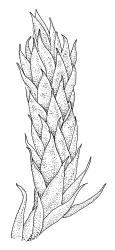- ≡ Hookeria sect. Sauloma Hook.f. & Wilson in Wilson, Bot. Antarct. Voy. II (Fl. Nov.-Zel.) Part II, 122 (1854)
Plants medium-sized, soft, white- or yellow-green, not iridescent, forming rather dense erect or less often pendent mats. Stems sparsely branched, mostly weakly erect. Leaves symmetric, uniform in size throughout shoot, erect-spreading when moist, oblong to ovate-lanceolate, mostly obtuse and strongly reflexed at apex, very weakly bordered, mostly entire. Costae absent or very weak and double. Upper laminal cells smooth, linear-rhomboid, porose. Gemmae fusiform and axillary.
Dioicous. Perichaetial leaves differ from vegetative leaves only by size. Setae lateral, straight, smooth, mostly red-brown; capsules inclined to horizontal, symmetric, ovoid or elongate-ovoid, papillose when mature and dry; operculum high-conic. Peristome teeth brownish-yellow, linear-lanceolate, furrowed, densely and finely cross-striate, with high lamellae and laterally projecting trabeculae; endostome yellowish, finely papillose, with a moderately high basal membrane; segments well developed, perforate; cilia absent. Calyptra mitrate, naked. Spores 1-celled, variable in size.
A genus of fewer than 5 species, occurring in Australasia and South America. According to Streimann (2000) the genus also occurs in south-east Asia and east Africa. The type species occurs in N.Z.
Matteri (1972) has reviewed the occurrence of the genus in southern South America, from whence only S. tenella is known. Streimann (2000) likewise considered that only S. tenella occurred in Tasmania and mainland Australia. Dixon (1927, p. 279) included Sauloma in his key to the genera of Hookeriaceae, but inexplicably failed to discuss the genus further.
Buck (1987) placed the monotypic Bolivian genus Pulvinella in synonymy here, while rejecting Crosby’s (1974) earlier placement of Achrohypnella Herzog (a monotypic and poorly known Chilean genus) in synonymy. Achrohypnella and Sauloma are retained as separate genera by Matteri (1972), presumably at least partly due to their difference in sexuality.
| Category | Number |
|---|---|
| Indigenous (Non-endemic) | 1 |
| Total | 1 |
Hypnum amiantum Stirt. in Paris is a nom. nud. Material so-named is in the Buchanan Herbarium (WELT M005831) and is S. tenella. Its exact provenance is obscure.
Plagiothecium helvolum Müll.Hal. in Paris is a nom. nud. based on R. Helms 12 (CHR 573778), probably from near Greymouth. The Helms collection is S. tenella.




